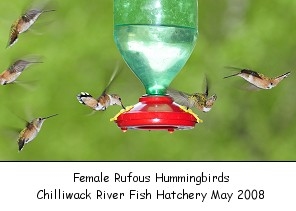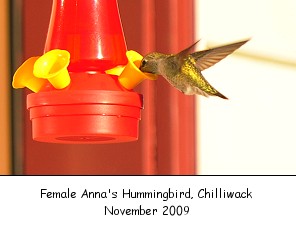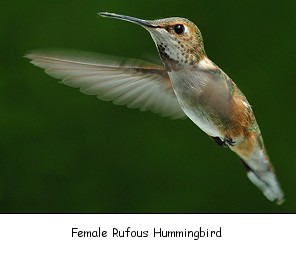Hummingbird Feeding Tips
By Gord Gadsden
Attracting hummingbirds to your backyard is fairly easy and is very rewarding. Rufous Hummingbirds are the most common species we are likely to  have in our backyards here in the Fraser Valley. However, Anna's Hummingbirds are becoming increasingly common, especially in Abbotsford and Chilliwack but they are spreading further eastwards. What is unique about the Anna's Hummingbird is that they remain in the area all year long even when the other species are gone south on migration. Calliope Hummingbird has also been sighted at feeders in the Upper Fraser Valley, usually on spring migration. Rare hummingbird species are always possible too. Costa's Hummingbird, a hummingbird from the southern states, have visited feeders three times in the Upper Fraser Valley to date. Black-chinned Hummingbirds are also seen once in a while as they migrate to the interior of the province. have in our backyards here in the Fraser Valley. However, Anna's Hummingbirds are becoming increasingly common, especially in Abbotsford and Chilliwack but they are spreading further eastwards. What is unique about the Anna's Hummingbird is that they remain in the area all year long even when the other species are gone south on migration. Calliope Hummingbird has also been sighted at feeders in the Upper Fraser Valley, usually on spring migration. Rare hummingbird species are always possible too. Costa's Hummingbird, a hummingbird from the southern states, have visited feeders three times in the Upper Fraser Valley to date. Black-chinned Hummingbirds are also seen once in a while as they migrate to the interior of the province.
While feeding hummingbirds with nectar feeders is very popular, a variety of plants, which will be listed below, can also be
grown to make your backyard into a hummingbird haven. Hummingbird food is cheap and very easy to make. To make hummingbird food, simply take one part white granulated sugar and four parts boiled water. Stir well, cool and store any extra in your refrigerator for a couple days. Boiling sterilizes the water which also helps the food last longer. This ratio of sugar to water mimics natural nectars which the hummingbirds feed on. Adding more or less sugar is not a good idea.
Do not use food colouring! It is potentially harmful to the hummingbirds and won't make the food or feeder any more attractive to the hummingbirds. While red is indeed a favourite colour for hummingbirds, the colour on the hummingbird feeder is more than enough to attract them. Same for the hummingbird food solutions bought in the store. I would be hesitant to use it not knowing what is used to create it. Also this store-bought food is almost always dyed anyway.
Honey is harmful to hummingbirds and should never be used either. Keep it simple and use the sugar water.
Hummingbird food should be replaced every 4 or 5 days to prevent it from going bad. In warm weather, replacing the food every 2 days may be necessary. Putting enough food to last as long as the weather will allow the food to stay fresh is best. Unless you have huge numbers of hummingbirds, such as at the Chilliwack River Fish Hatchery (they go through over 50 lbs of sugar in a season!) they won't empty a fully filled feeder before the food should be changed. Rinse the feeder well, inside and out, with a mixture of warm vinegar and water between refills.
Feeder Care
If any mold or other grossness appears on the inside of the feeder, it should be cleaned more thoroughly than with just vinegar water. Special brushes can be bought at your bird feeding store which helps scrub out the inside of your feeder. However, it is a very good idea to be proactive and not let your feeder get unsanitary and possibly harm your hummingbirds.
Where to put a Feeder
Hummingbirds don't seem to be too picky where the feeder is placed. We even have a feeder a few inches from our window and it gets well used. Try to find a place out of the direct sun as the heat will cause the food to turn more quickly. While small, hummingbirds, especially males, are very territorial. One male can try to monopolize a backyard feeding station and will try to chase away all other hummingbirds. To get around this problem if it occurs, try placing your feeders in various locations out of the direct line of sight from each other.

When to put up a Feeder
Rufous Hummingbirds, typically the males, usually arrive in middle to late March often when the salmonberry and red flowering current shrubs are blooming. Females arrive  afterwards and will usually stick around longer into the summer than the males. After breeding, the male leaves the nest building and raising the young to the females. Adult males will leave on their southwards journey before females and the year's young will. Anna's Hummingbirds, as previously mentioned, won't migrate and will especially depend on hummingbird feeders over the winter. If you have Anna's Hummingbirds, or wish to attract them (remember, their range is expanding!), leave your feeders up. If it is cold enough to freeze the food, people have come up with inventive methods with flood lamps and heaters to keep the food from freezing. Check in on the discussion forum for more information on tips to keep feeders from freezing in the cold. Otherwise, if you're not sure you're up to the task of supporting Anna's Hummingbirds through the winter consider not leaving your feeders out past September. Click here for an article on winter hummingbird feeding afterwards and will usually stick around longer into the summer than the males. After breeding, the male leaves the nest building and raising the young to the females. Adult males will leave on their southwards journey before females and the year's young will. Anna's Hummingbirds, as previously mentioned, won't migrate and will especially depend on hummingbird feeders over the winter. If you have Anna's Hummingbirds, or wish to attract them (remember, their range is expanding!), leave your feeders up. If it is cold enough to freeze the food, people have come up with inventive methods with flood lamps and heaters to keep the food from freezing. Check in on the discussion forum for more information on tips to keep feeders from freezing in the cold. Otherwise, if you're not sure you're up to the task of supporting Anna's Hummingbirds through the winter consider not leaving your feeders out past September. Click here for an article on winter hummingbird feeding
Ants and Wasps
Ants and wasps can be very annoying. Wasps can be prevented by using bee guards or buying hummingbird feeders designed to exclude wasps. Ants, once they have located a hummingbird feeder, will be constant visitors. Barriers can be bought,such as little water moats, to keep ants away. I have, in the past, also effectively used Tree Tanglefoot in a very small amount on the wire that the feeder hangs from. This product is designed to keep insects from walking over it. However, I always worried about what could have if a bird came in contact with it so used it only in extreme cases and in small amounts.
Other birds, such as orioles like nectar feeders. They may try to feed at a hummingbird feeder. If you have orioles, special feeders for orioles are on the market. I used to get House Finches feeding at my hummingbird feeders. For two years, they (probably the same birds) discovered how to pull out the bee guards so they could reach the sugar water. I was constantly sticking the bee guards back on the feeder and sometimes even replacing them if I forgot to collect them before I mowed the lawn. This seemed to be an isolated incident as I have never had it happen again nor have I often heard of other people experiencing it. Clever birds! Our Black-capped Chickadees will also enjoy a sip at a feeder if it does not have a bee guard in place.
Plants that attract hummingbirds
Try growing some of the plants listed below to attract hummingbirds. If possible, use native plants instead of introduced ones. Some of the species listed below are invasive plants and have the ability to overwhelm native species if they manage to 'escape' your yard. Always be careful when disposing of prunings or parts of non-native plants. Even a part of some plants can take root and spread.
Flowers
Cardinal Flower Lobelia cardinalis
Lantana Lantana camara
Red Columbine Aguilegia formosa (native)
Fuchsia Fuchsia sp.
Impatiens Impatiens sp.
Coral-Bells Heuchera sanguinea
Hollyhocks Althea sp.
Penstemen Penstemen sp.
Petunia Petunia sp.
Flowering Tobacco Nicotania alata
Geranium Pelargonium sp.
Begonia Begonia sp.
Bleeding Heart Dicentra formosa (native)
Agastache (Hummingbird Mint)
Kniphofia
Shrubs
Azaleas Rhododendron sp.
Butterfly Bush Buddleia davidii (can be invasive if it escapes!)
Flowering Quince Chaenomeles japonica
Trumpet Honeysuckle Lonicera cilosa (native)
Weigela Weigela sp.
Salmonberry Rubus spectabilis (native)
Red-Flowering Current
Ribes sanguineum (native)
Trees
Pacific Crab Apple Malus fusca (native)
Good luck and have fun!

|